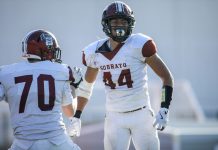Dirt bike racers at the Hollister Hills Grand Prix track could
be slapped with a strict noise limit on their cacophonous bikes as
a way to bring the park into compliance with its noise standard,
according to state officials. A noise ordinance instated last year
cut the number of promoters sponsoring races almost in half, and
racing enthusiasts believe a stricter ordinance could drive even
more people away.
Dirt bike racers at the Hollister Hills Grand Prix track could be slapped with a strict noise limit on their cacophonous bikes as a way to bring the park into compliance with its noise standard, according to state officials. A noise ordinance instated last year cut the number of promoters sponsoring races almost in half, and racing enthusiasts believe a stricter ordinance could drive even more people away.
In January of last year, Hollister Hills became the first public track in the state to set a tested limit of 99 decibels for dirt bikes, said park employee Daniel Dungy. Before that the bikes were exempt from noise limits during racing events.
The cap irritated many riders because limiting the noise level means limiting the horsepower, and less power means less chance of getting to the finish line first. While everyone riding at Hollister Hills would be hindered the same amount, spending the extra cash to quiet a bike to ride on only one track in a state with many tracks has turned some riders away from Hollister Hills.
But park officials are now thinking of lowering the 99 limit to 96 decibels because they still are not in compliance with the park’s noise standard, Dungy said.
When the park added on about 3400 acres a number of years ago, in its Environmental Impact Report it stated it would establish a noise standard, he said. It didn’t do that and was sued by neighbors, wineries and surrounding land owners. The park settled, and in accordance with the agreement it agreed to create a noise policy to comply with the settlement, Dungy said.
Throughout 2004, professional sound monitors tested specific areas of the park to make sure the sound level was in compliance with the EIR, Dungy said. The only area out of compliance was the area near the race track, he said. Hollister Hills monitors overall decibel output by taking readings at timed intervals about every other week, which correspond to benchmarks defined in the settlement agreement.
Capping the bikes at 99 lowered the collective sound reading for the area near the track only a couple decibels, and the park needs to get that average noise down at least eight decibels to come into compliance with the EIR, Dungy said.
To do that, park staff are discussing lowering the individual bike limit to 96 decibels, or limiting the number of riders on the track at one time to about 30 instead of 40, Dungy said. They will make a decision about the possible reductions within a couple months, he said.
“We could say we’re shutting the track down and that would solve the problem for noise, but it wouldn’t solve the problem of, what do the riders do now?” Dungy said. “We want to keep that place open, but we also want to be responsible people.”
After putting a decibel limit on the bikes during races, the number of events at the track was slashed from 36 to 20, Dungy said.
One of Hollister Hills biggest promoters in 2003, AMP Racing, pulled most of their events in 2004 and don’t have a single event booked for 2005, said owner Jack Azevedo, Jr.
Azevedo said riders have to buy extra equipment to silence their loud mufflers in order to ride at Hollister Hills and many don’t want to race there anymore.
“We hate the sound thing because we hate to lose it. It’s a good facility,” he said. “But the riders don’t want to mess with it so they just go to another race. It hurts us business-wise.”
Matt Presser, an avid dirt bike rider, said putting a limit of 99 on bikes was bad enough, and 96 will drive people away for good.
“You buy all that trick stuff to race and if you have to put a cork in your silencer it defies the whole point of racing. Horsepower’s loud,” Presser said. “Hollister’s an awesome track. But there’s so many strict laws people don’t even like to go up there.”
Presser said there’s plenty of race tracks around Hollister, like ones in San Jose, Livermore, Turlock and Madera that don’t have noise limits. And to ride freely with very little to no restrictions at all, they go to the Clear Creek Management Area.
Although there’s no track at Clear Creek, Presser said it doesn’t matter because, “you can make your own track there.”
Hollister Hills Advisory Committee is holding a public meeting on Jan. 25 to discuss the noise monitoring contract, not the limiting of the decibel level, Dungy said. But if people have questions or concerns about any issue at the park, they can voice their concerns during the committee’s public comment period, he said.
The meeting is located at the San Benito County Board of Supervisors Chambers at 481 Fourth St. in Hollister at 7pm.
Erin Musgrave covers public safety for the Free Lance. Reach her at (831)637-5566, (ext. 336) or em*******@***********ws.com







